Live Project: Negotiated Studio Practise .
This module has been divided into two parts for ease of viewing. Scroll down to view how this module progressed.
scroll
Digital Sketchbook Reflection (October to December)
Initially, after dissecting the brief I felt lost on where to start. The brief I’d found from Art Rabbit a gave strong analysis of how they see algorithms altering the body, but I wasn’t sure how I fit within this narrative. It wasn’t until I searched for algorithmic art that I found Chromata and subsequently Michael Bromley. This exploration into a new subsect of digital art was a huge revelation, and a driver into the work I have come to create.
The brief I created for myself, was in direct response to Art Rabbit’s call to artists/creatives and is the basis of this period of work. I found myself intrigued as to how the algorithms, which are intwined with every aspect of our life, are affecting our bodies and furthermore, how far has this gone? Where is the line for us? And how can we make art to reflect this?
After posing these questions, subsequent research found that even our digital art has lent itself to algorithms. Chromata allows the algorithm to create art for you, you don’t even need to put any effort in it. The JavaScript tool allows users to input images for the algorithms to respond to. They then respond to the information it has received, putting out its own ‘version’ of the art. Using pathfinders which are input by the user, we can create a ‘splash zone’ in which we can guide the generative coding. Yet we cannot fully control the algorithms and the outcome of its output. It made perfect sense to then input images of a body to this coding, to really see what might happen physically to a body when coding can be let loose. Additionally, my core studio practise work centres around the female nude, and the body in general so this was perfect for me. The initial visual research responses were a great starter to an exciting journey.
Playing with the variables has allowed me to discover how they might affect the outcome image. The path finder’s key, line width, origin, and output size all effect how the coding will respond (Figure 1). Looking at Figure 2,3,4,5 and 6, it is possible to see how the results to my initial introduction to the software. The images were created in standard settings, and I did not change the variables at all.
The experimenting further, I increased the line width (to 6300) which had a dramatic effect on the outcomes. Inputting a new image (a photograph compared to my digital artwork as used previous) again yielded different results. The beauty of the Chromata software is that when you set the algorithm working, you can view the process live; You can watch the coding run before your eyes. This allowed me to stop and pause at any time to review the progress and take stock as well as take still images.
From this point, I really started to run with it. Changing and experimenting with all the variables gave me a solid body of work. From this play, I have been able to distinguish that circular line path became interesting in various sizes (7,8,9 show examples of this). I also really enjoy the wirey type images (10,11,12), they have a crystal type quality which is successful and quite powerful.
Just to experiment further, I wanted to put a different type of image through the program to see what might happen. Putting a picture of one of my prints yielded a different result than I had expected. Although they aren’t on the directive of the ‘body in algorithms’, they do have the same wirey feel as some of the other pieces (Figure 13,14,15). The marks remind of the wires, networks and cables that bring the internet to us.
The visual quality of all the pieces bring something I wasn’t expecting. Each piece explores the reaction of an algorithm with interesting results. My favourites are Figure 16, 17, 18. The first image (Figure 16) is an abstract simulation of a body, and I enjoy the colour pallet within it. I can also appreciate its inconspicuous nature, if this was to be displayed in a public domain, it would be able to exist without rebuttal for being an indecent image
viewed by the community. Figure 14 is the opposite of this. Created from the same input image, I modified the variables to achieve a different outcome. Smaller path finders allowed the coding to plot smaller pins, creating a clearer image. As the viewer, we can understand and read this image easier, filling in the gaps to understand that this image is of a figure.
Finally, Figure 18 presents a different set of visual characteristics which are enjoyable. The scratchy, wirey nature of the lines allow for the illusion and hint of a figure within the piece, but it is not as obvious, and one must really look for it. Knowing how this piece was made, it’s quite nice to see that this is evident in the image itself. The marks look like wires/coding and this is aided by its monochromatic colour.
From this period of work, I’ve come to appreciate how important the algorithm is to creating a body of work. I will need to consider how this might relay to the viewer, and whether letting them in on how these works came to be will either add or remove of the overall piece. Initially, I didn’t contemplate where I might display my work at the end of the module. It seemed irrelevant, and I wanted to focus on the making/play process of the work. But as I’ve progressed in this journey, I’m realising that the end is just as important as the progression.
With this in mind, I would like to try creating my own algorithm. It would be interesting to see how my own coding might generate different types of work, and what they might look like. Plus, it would be good to learn how the coding is created to input my own parameters in which it can operate. Finally, I would like to research further into other artists who are creating algorithmic art, whether through a generator or other programs.
Figure 1

Figure 2

Figure 3

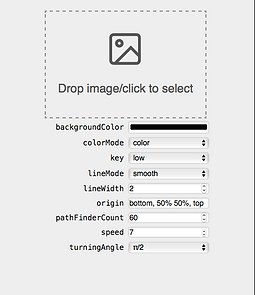

Figure 4

Figure 5


Figure 8
Figure 9

Figure 13
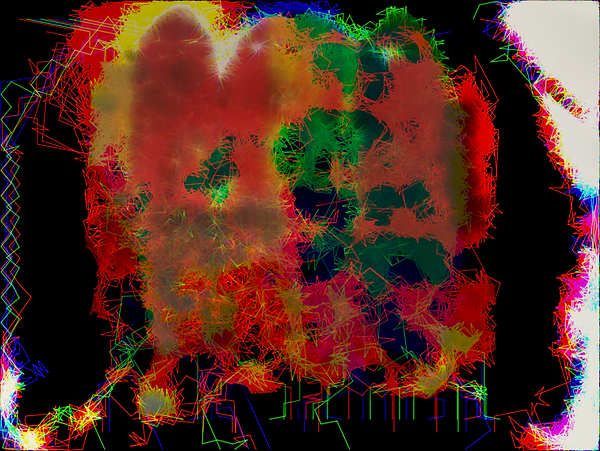
Figure 14
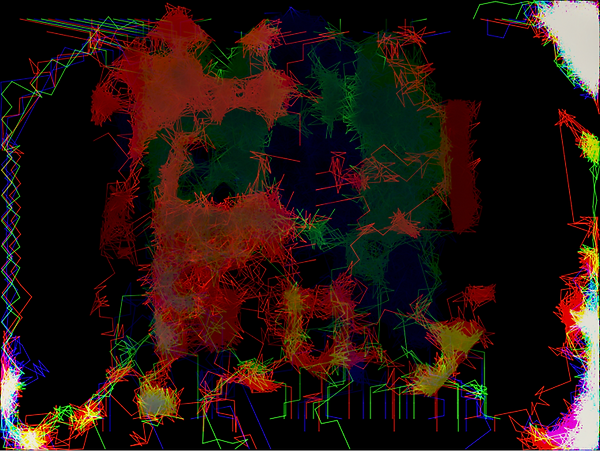
Figure 17
Live Project: Negotiated Studio Practise .
This module has been divided into two parts for ease of viewing. Scroll down to view how this module progressed.
scroll
Digital Sketchbook Reflection (January to April 2021)
When starting this work there are many things I hadn’t considered. Mainly I hadn’t considered fully the aspect that this work could be viewed in the public domain, and how that might be displaying pieces in a setting that has a few societal norms and rules. The ramifications of this only came to me from discourse in the group crit session just before Christmas 2020. As I was explaining the work, and showing my fellow students what had done, it was mentioned that these pieces have the possibility to be viewed by all people of the community. This encouraged me to ponder two things. Firstly, how the community might see my work, and the ramifications of young children and vulnerable people viewing such images. Although in most of the pieces, you could not see a nude figure, in some works there were Secondly, I also wanted to consider whether the viewer should understand how the work was made. Would this be better to show (possibly with a small caption by each piece explaining how the work was done) or would it be better to allow an inkling of the theme of the work to be shown in the piece itself. Showing the algorithms in the body or demonstrating the coding that makes up this work is a key part of its integrity and its identity. I think it’s important that this is demonstrated to the viewer as they can fully appreciate the magnitude of the work, but also how it’s been made. Moving forward, I do feel that the place in which I show this work does impact the work itself.
The first choice that I considered would be the carpark in Chester city centre, however I’m not sure that this would be an ideal place as the environment must lend itself to the work and the context of why it has been created. The BT boxes do show this in a great way. It is serendipity the fact that the BT boxes are the means in which the Internet is carried into our homes, that I may also show my pieces on these boxes. The community can see the work that I have created by algorithms and coding and see that as a branding on the box as it sits outside on someone’s street. As it was mentioned to me in one of the group critical sessions, the BT box with my work on top of it, will literally be doing ‘what it says on the tin’. I think it is also important to mention that it is a full circle moment that I have used algorithms and coding to create artwork and the artwork is then displayed on a box that also transmits algorithms and coding to our homes. With this in mind, I am conscious of the fact that my pieces may need to be shown in a series. A collection of works on show together in a concentrated area i.e., Chester to have maximum impact.
As mentioned previously, I did try to set up my own set of coding. However, this didn’t go to plan and I found it extremely difficult to set up the algorithms. It wasn’t something that I had expected to be an issue, when I got into creating it however, I found that the algorithms would not operate in a way that I wish they would. I then decided to go back to my original program Chromata and continue to use this as I knew it would give me the results that I needed and wanted. had been my trusty tool to create work and has created a lot of good work previously so I figured why stop and change. This time, I wanted to strike that fine line between showing the body (or just enough of it) and showcasing the way in which the art has been made. It would be nice for the viewer to also be in on the secret as to what the art is.
Moving forward, I began using Chromata to create images as I had before but tweaking the input values to modify the outcome. Although I cannot completely predict the final piece outcome, but I can make a ‘splash zone’ to set parameters of the algorithm. Figures 1, 2, 3, 4, 5, 6, 7 & 8 show examples of key pieces from this period of work. I also used different input images as well to see how that might affect it too. I do feel that this round of images work so well, and I can see them looking good out in the real world. The more I’m thinking about it, the more I realise that the BT boxes would be an ideal location to display this work.
Through contextual research I’ve also been able to see how artists also navigate digital art and blend this with figurative subject matter. Artist Janusz Jurek has created a series of digital paintings entitled Papilarnie III (N.D) in which he creates digital art using online software, merging figurative art with a digital medium (Figure 9, 10, 11, 12, 13 & 14). A Polish artist, Jurek has managed to strike the balance between expressive lines and a clear, legible subject matter (mainly limbs). It’s something I’ve wanted to implement within my own work, and I hope I have achieved that. By looking at Jurek’s work I’ve come to understand that a series of works is quite powerful and gives a full, rounded view of the pieces. This is something I want to do for my own art, and with multiple BT boxes all over the city it would be perfect to put them in different locations.
Going through the work generated so far, I’ve narrowed it down to six final images that I wish to use in situ (Figure 15, 16, 17, 18, 19 & 20). I’ve selected these final six because I feel they are a complex and full view of this journey creating the art. They give just enough of the body, a figurative hint which allow them to occupy this very public setting whilst still be true to me and my style. However, more importantly, they also showcase the means in which the art was created. The algorithms can be seen, and I hope, read by the viewer. Finally, I wanted to choose different varieties of images to vary what would be shown to the public. Additionally, I’ve super-imposed my final six on top of already existing images of the BT boxes, just to give me a look at what they might look like. Of course, with Covid-19 disruptions, I am aware that the end of this project will not complete as we would have hoped. Although these works won’t be seen in there intended space, this exercise was extremely useful to visualize what they could have looked like. I’m happy with my decisions to show multiple works, strangely amongst the graffiti that already exists on the boxes, they look very clean and simple. I find it odd that these images can be seen as ‘dirty’ yet next to the existing graffiti they are subtle and just enough.
Lastly, this project has been an exciting challenge which has taught me so many skills. As an artist who primarily works within physical painting, switching to digital media has been demanding yet so rewarding. I didn’t think I would ever have been this comfortable on a computer, let alone generate a coherent and strong body of work. At a time with such disruption and confusion, it has been empowering to find a new way of working. I’m proud of these pieces, as well as my dedication to bettering myself as an artist.

Figure 1

Figure 3

Figure 4

Figure 7

Figure 8

Figure 9





Janusz Jurek, Papilarnie III, Not dated.


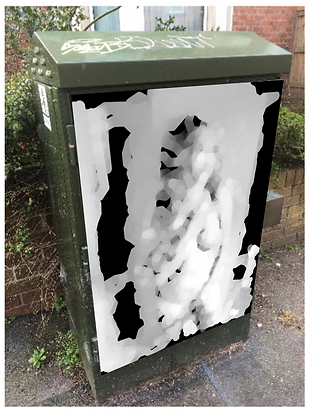

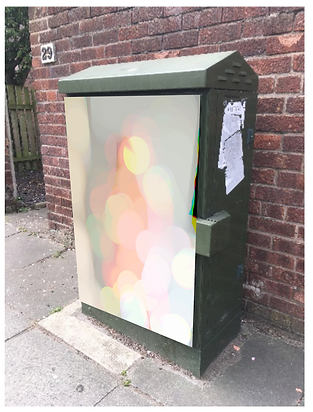
Figure 15, 16, 17, 18, 19 & 20